Accounting: Financial Statements, Ratio Analysis, Bank Account
VerifiedAdded on 2023/01/09
|15
|3321
|78
AI Summary
This document provides an introduction to accounting and discusses the financial statements of Bob's account. It also explains the three main features of information for users of financial statements. The document includes a calculation of ratios and their interpretation. It also provides a step-by-step guide to writing up the bank account and balancing other accounts.
Contribute Materials
Your contribution can guide someone’s learning journey. Share your
documents today.
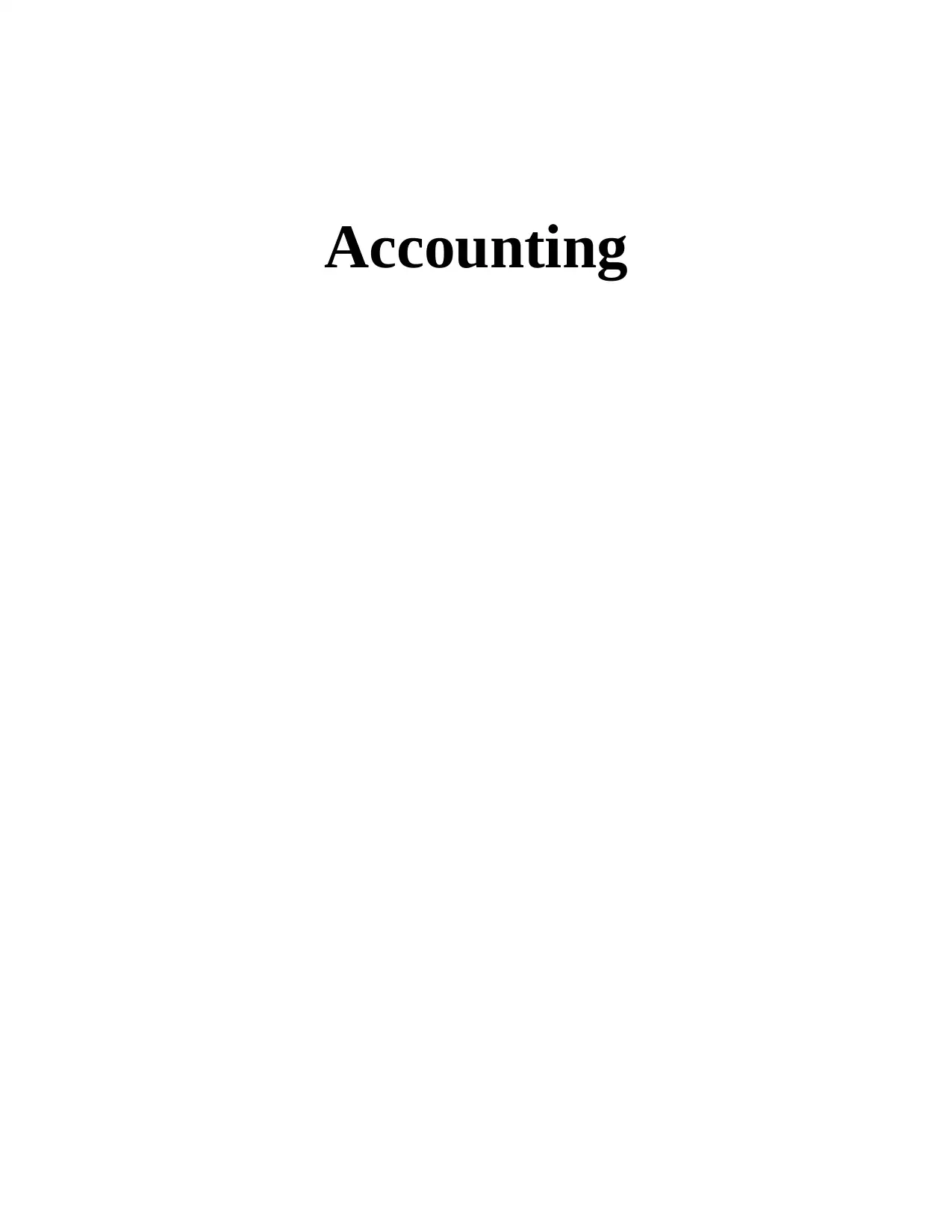
Accounting
Secure Best Marks with AI Grader
Need help grading? Try our AI Grader for instant feedback on your assignments.

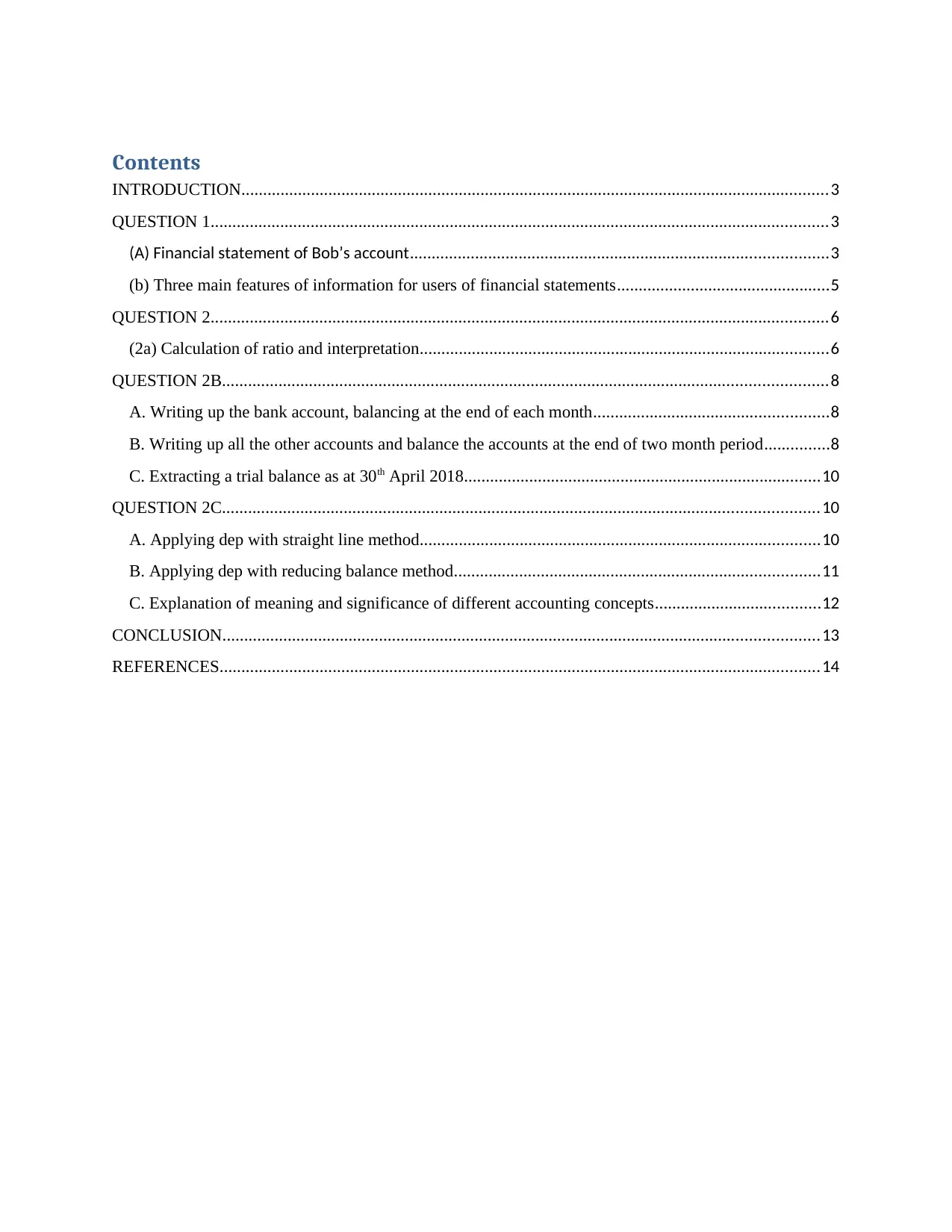
Contents
INTRODUCTION.......................................................................................................................................3
QUESTION 1..............................................................................................................................................3
(A) Financial statement of Bob’s account................................................................................................3
(b) Three main features of information for users of financial statements.................................................5
QUESTION 2..............................................................................................................................................6
(2a) Calculation of ratio and interpretation..............................................................................................6
QUESTION 2B...........................................................................................................................................8
A. Writing up the bank account, balancing at the end of each month......................................................8
B. Writing up all the other accounts and balance the accounts at the end of two month period...............8
C. Extracting a trial balance as at 30th April 2018..................................................................................10
QUESTION 2C.........................................................................................................................................10
A. Applying dep with straight line method............................................................................................10
B. Applying dep with reducing balance method....................................................................................11
C. Explanation of meaning and significance of different accounting concepts......................................12
CONCLUSION.........................................................................................................................................13
REFERENCES..........................................................................................................................................14
INTRODUCTION.......................................................................................................................................3
QUESTION 1..............................................................................................................................................3
(A) Financial statement of Bob’s account................................................................................................3
(b) Three main features of information for users of financial statements.................................................5
QUESTION 2..............................................................................................................................................6
(2a) Calculation of ratio and interpretation..............................................................................................6
QUESTION 2B...........................................................................................................................................8
A. Writing up the bank account, balancing at the end of each month......................................................8
B. Writing up all the other accounts and balance the accounts at the end of two month period...............8
C. Extracting a trial balance as at 30th April 2018..................................................................................10
QUESTION 2C.........................................................................................................................................10
A. Applying dep with straight line method............................................................................................10
B. Applying dep with reducing balance method....................................................................................11
C. Explanation of meaning and significance of different accounting concepts......................................12
CONCLUSION.........................................................................................................................................13
REFERENCES..........................................................................................................................................14
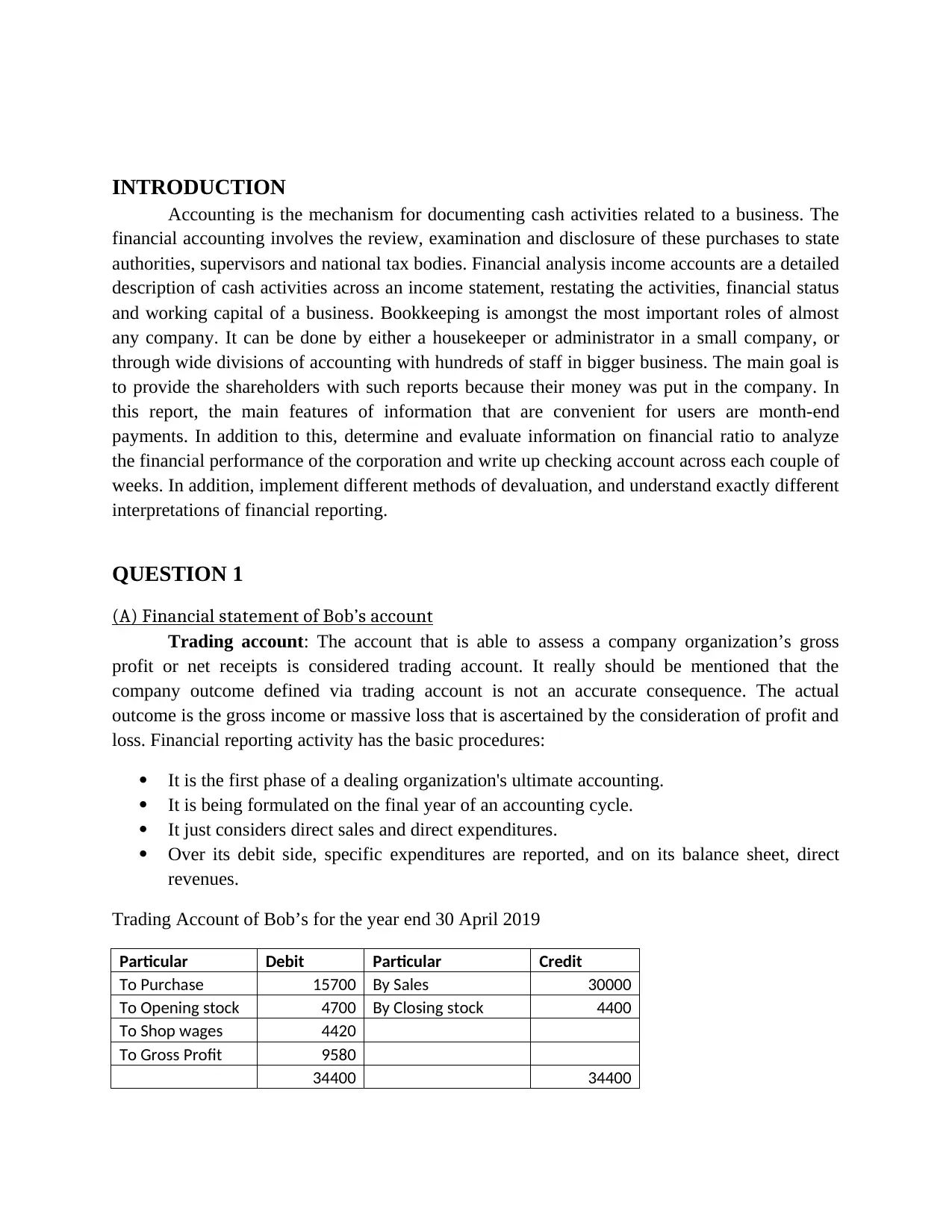
INTRODUCTION
Accounting is the mechanism for documenting cash activities related to a business. The
financial accounting involves the review, examination and disclosure of these purchases to state
authorities, supervisors and national tax bodies. Financial analysis income accounts are a detailed
description of cash activities across an income statement, restating the activities, financial status
and working capital of a business. Bookkeeping is amongst the most important roles of almost
any company. It can be done by either a housekeeper or administrator in a small company, or
through wide divisions of accounting with hundreds of staff in bigger business. The main goal is
to provide the shareholders with such reports because their money was put in the company. In
this report, the main features of information that are convenient for users are month-end
payments. In addition to this, determine and evaluate information on financial ratio to analyze
the financial performance of the corporation and write up checking account across each couple of
weeks. In addition, implement different methods of devaluation, and understand exactly different
interpretations of financial reporting.
QUESTION 1
(A) Financial statement of Bob’s account
Trading account: The account that is able to assess a company organization’s gross
profit or net receipts is considered trading account. It really should be mentioned that the
company outcome defined via trading account is not an accurate consequence. The actual
outcome is the gross income or massive loss that is ascertained by the consideration of profit and
loss. Financial reporting activity has the basic procedures:
It is the first phase of a dealing organization's ultimate accounting.
It is being formulated on the final year of an accounting cycle.
It just considers direct sales and direct expenditures.
Over its debit side, specific expenditures are reported, and on its balance sheet, direct
revenues.
Trading Account of Bob’s for the year end 30 April 2019
Particular Debit Particular Credit
To Purchase 15700 By Sales 30000
To Opening stock 4700 By Closing stock 4400
To Shop wages 4420
To Gross Profit 9580
34400 34400
Accounting is the mechanism for documenting cash activities related to a business. The
financial accounting involves the review, examination and disclosure of these purchases to state
authorities, supervisors and national tax bodies. Financial analysis income accounts are a detailed
description of cash activities across an income statement, restating the activities, financial status
and working capital of a business. Bookkeeping is amongst the most important roles of almost
any company. It can be done by either a housekeeper or administrator in a small company, or
through wide divisions of accounting with hundreds of staff in bigger business. The main goal is
to provide the shareholders with such reports because their money was put in the company. In
this report, the main features of information that are convenient for users are month-end
payments. In addition to this, determine and evaluate information on financial ratio to analyze
the financial performance of the corporation and write up checking account across each couple of
weeks. In addition, implement different methods of devaluation, and understand exactly different
interpretations of financial reporting.
QUESTION 1
(A) Financial statement of Bob’s account
Trading account: The account that is able to assess a company organization’s gross
profit or net receipts is considered trading account. It really should be mentioned that the
company outcome defined via trading account is not an accurate consequence. The actual
outcome is the gross income or massive loss that is ascertained by the consideration of profit and
loss. Financial reporting activity has the basic procedures:
It is the first phase of a dealing organization's ultimate accounting.
It is being formulated on the final year of an accounting cycle.
It just considers direct sales and direct expenditures.
Over its debit side, specific expenditures are reported, and on its balance sheet, direct
revenues.
Trading Account of Bob’s for the year end 30 April 2019
Particular Debit Particular Credit
To Purchase 15700 By Sales 30000
To Opening stock 4700 By Closing stock 4400
To Shop wages 4420
To Gross Profit 9580
34400 34400
Secure Best Marks with AI Grader
Need help grading? Try our AI Grader for instant feedback on your assignments.
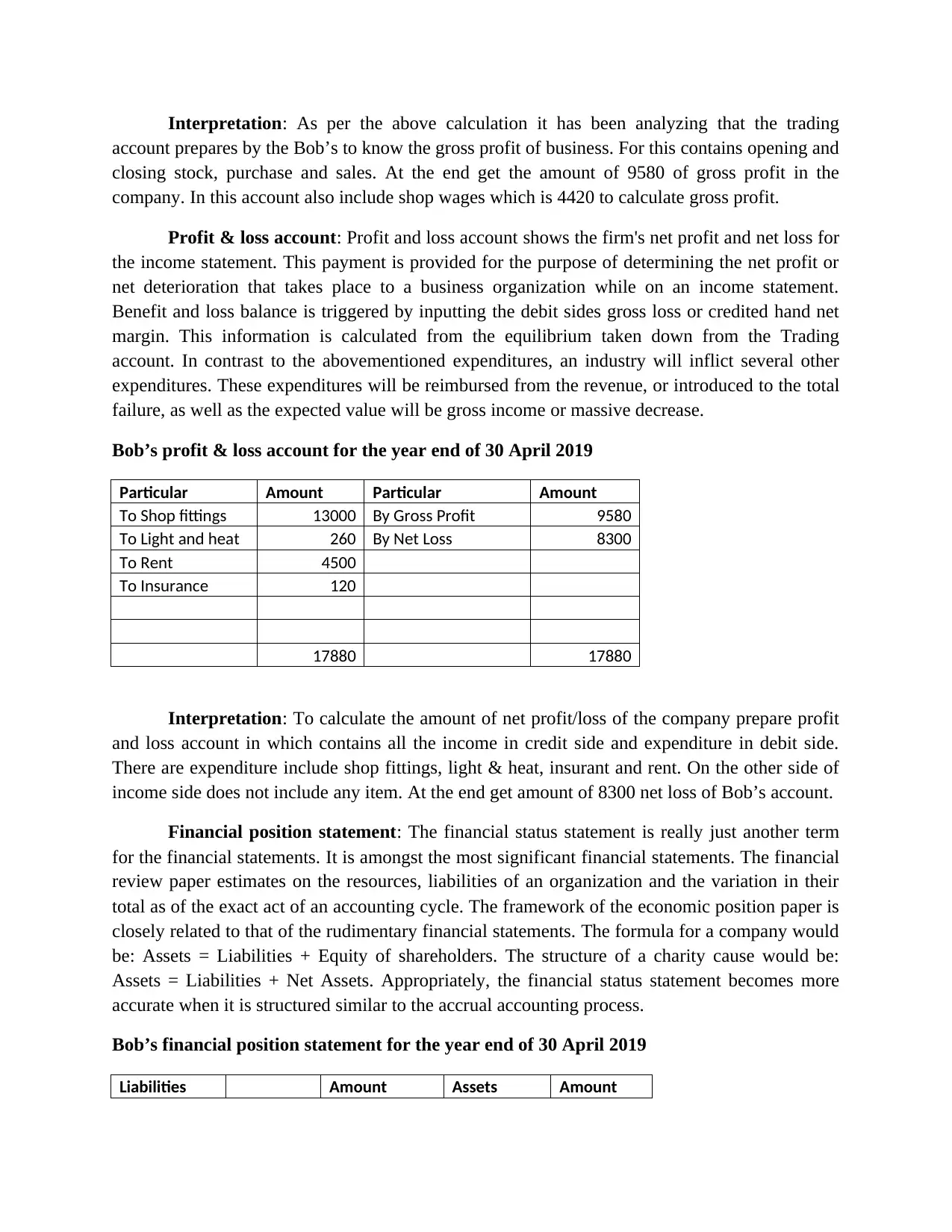
Interpretation: As per the above calculation it has been analyzing that the trading
account prepares by the Bob’s to know the gross profit of business. For this contains opening and
closing stock, purchase and sales. At the end get the amount of 9580 of gross profit in the
company. In this account also include shop wages which is 4420 to calculate gross profit.
Profit & loss account: Profit and loss account shows the firm's net profit and net loss for
the income statement. This payment is provided for the purpose of determining the net profit or
net deterioration that takes place to a business organization while on an income statement.
Benefit and loss balance is triggered by inputting the debit sides gross loss or credited hand net
margin. This information is calculated from the equilibrium taken down from the Trading
account. In contrast to the abovementioned expenditures, an industry will inflict several other
expenditures. These expenditures will be reimbursed from the revenue, or introduced to the total
failure, as well as the expected value will be gross income or massive decrease.
Bob’s profit & loss account for the year end of 30 April 2019
Particular Amount Particular Amount
To Shop fittings 13000 By Gross Profit 9580
To Light and heat 260 By Net Loss 8300
To Rent 4500
To Insurance 120
17880 17880
Interpretation: To calculate the amount of net profit/loss of the company prepare profit
and loss account in which contains all the income in credit side and expenditure in debit side.
There are expenditure include shop fittings, light & heat, insurant and rent. On the other side of
income side does not include any item. At the end get amount of 8300 net loss of Bob’s account.
Financial position statement: The financial status statement is really just another term
for the financial statements. It is amongst the most significant financial statements. The financial
review paper estimates on the resources, liabilities of an organization and the variation in their
total as of the exact act of an accounting cycle. The framework of the economic position paper is
closely related to that of the rudimentary financial statements. The formula for a company would
be: Assets = Liabilities + Equity of shareholders. The structure of a charity cause would be:
Assets = Liabilities + Net Assets. Appropriately, the financial status statement becomes more
accurate when it is structured similar to the accrual accounting process.
Bob’s financial position statement for the year end of 30 April 2019
Liabilities Amount Assets Amount
account prepares by the Bob’s to know the gross profit of business. For this contains opening and
closing stock, purchase and sales. At the end get the amount of 9580 of gross profit in the
company. In this account also include shop wages which is 4420 to calculate gross profit.
Profit & loss account: Profit and loss account shows the firm's net profit and net loss for
the income statement. This payment is provided for the purpose of determining the net profit or
net deterioration that takes place to a business organization while on an income statement.
Benefit and loss balance is triggered by inputting the debit sides gross loss or credited hand net
margin. This information is calculated from the equilibrium taken down from the Trading
account. In contrast to the abovementioned expenditures, an industry will inflict several other
expenditures. These expenditures will be reimbursed from the revenue, or introduced to the total
failure, as well as the expected value will be gross income or massive decrease.
Bob’s profit & loss account for the year end of 30 April 2019
Particular Amount Particular Amount
To Shop fittings 13000 By Gross Profit 9580
To Light and heat 260 By Net Loss 8300
To Rent 4500
To Insurance 120
17880 17880
Interpretation: To calculate the amount of net profit/loss of the company prepare profit
and loss account in which contains all the income in credit side and expenditure in debit side.
There are expenditure include shop fittings, light & heat, insurant and rent. On the other side of
income side does not include any item. At the end get amount of 8300 net loss of Bob’s account.
Financial position statement: The financial status statement is really just another term
for the financial statements. It is amongst the most significant financial statements. The financial
review paper estimates on the resources, liabilities of an organization and the variation in their
total as of the exact act of an accounting cycle. The framework of the economic position paper is
closely related to that of the rudimentary financial statements. The formula for a company would
be: Assets = Liabilities + Equity of shareholders. The structure of a charity cause would be:
Assets = Liabilities + Net Assets. Appropriately, the financial status statement becomes more
accurate when it is structured similar to the accrual accounting process.
Bob’s financial position statement for the year end of 30 April 2019
Liabilities Amount Assets Amount
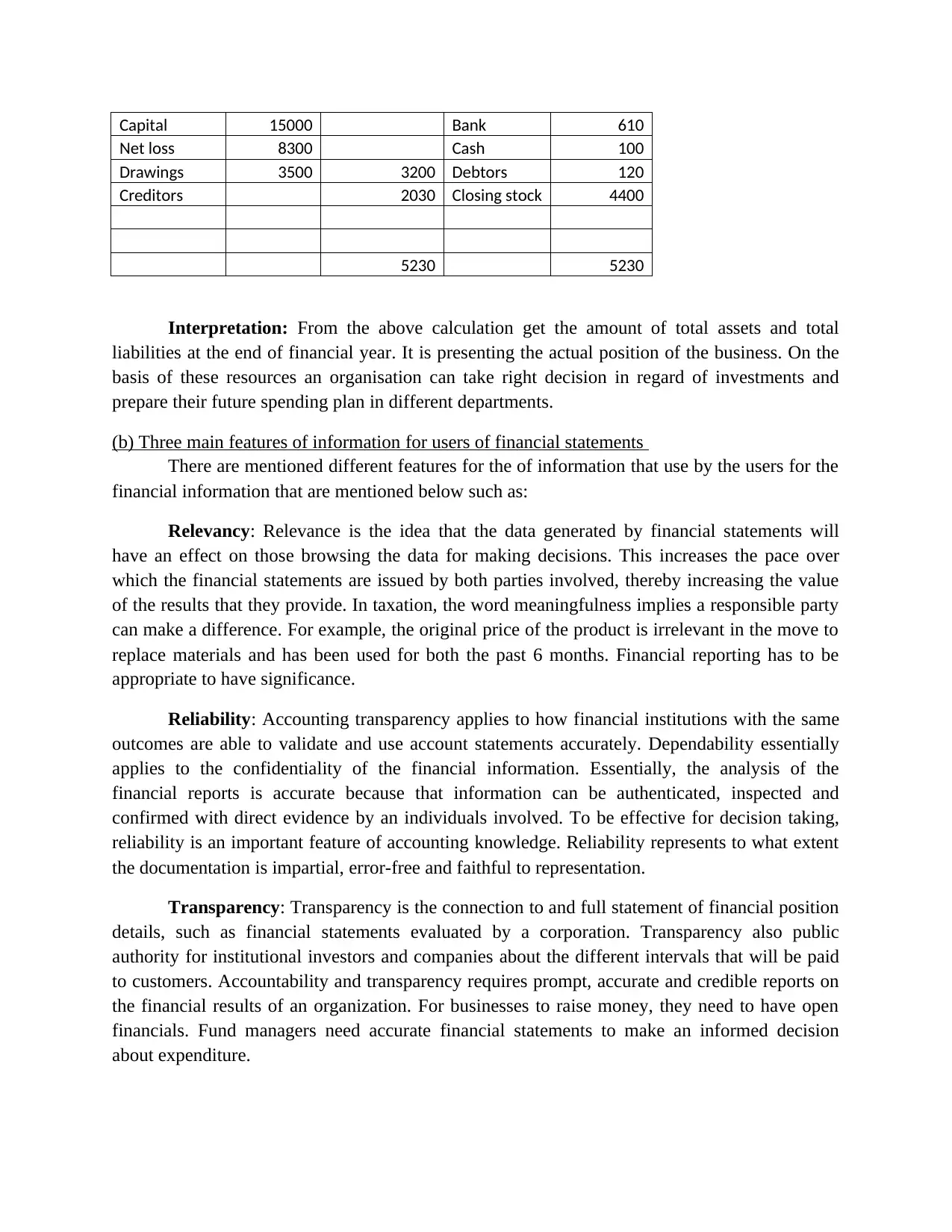
Capital 15000 Bank 610
Net loss 8300 Cash 100
Drawings 3500 3200 Debtors 120
Creditors 2030 Closing stock 4400
5230 5230
Interpretation: From the above calculation get the amount of total assets and total
liabilities at the end of financial year. It is presenting the actual position of the business. On the
basis of these resources an organisation can take right decision in regard of investments and
prepare their future spending plan in different departments.
(b) Three main features of information for users of financial statements
There are mentioned different features for the of information that use by the users for the
financial information that are mentioned below such as:
Relevancy: Relevance is the idea that the data generated by financial statements will
have an effect on those browsing the data for making decisions. This increases the pace over
which the financial statements are issued by both parties involved, thereby increasing the value
of the results that they provide. In taxation, the word meaningfulness implies a responsible party
can make a difference. For example, the original price of the product is irrelevant in the move to
replace materials and has been used for both the past 6 months. Financial reporting has to be
appropriate to have significance.
Reliability: Accounting transparency applies to how financial institutions with the same
outcomes are able to validate and use account statements accurately. Dependability essentially
applies to the confidentiality of the financial information. Essentially, the analysis of the
financial reports is accurate because that information can be authenticated, inspected and
confirmed with direct evidence by an individuals involved. To be effective for decision taking,
reliability is an important feature of accounting knowledge. Reliability represents to what extent
the documentation is impartial, error-free and faithful to representation.
Transparency: Transparency is the connection to and full statement of financial position
details, such as financial statements evaluated by a corporation. Transparency also public
authority for institutional investors and companies about the different intervals that will be paid
to customers. Accountability and transparency requires prompt, accurate and credible reports on
the financial results of an organization. For businesses to raise money, they need to have open
financials. Fund managers need accurate financial statements to make an informed decision
about expenditure.
Net loss 8300 Cash 100
Drawings 3500 3200 Debtors 120
Creditors 2030 Closing stock 4400
5230 5230
Interpretation: From the above calculation get the amount of total assets and total
liabilities at the end of financial year. It is presenting the actual position of the business. On the
basis of these resources an organisation can take right decision in regard of investments and
prepare their future spending plan in different departments.
(b) Three main features of information for users of financial statements
There are mentioned different features for the of information that use by the users for the
financial information that are mentioned below such as:
Relevancy: Relevance is the idea that the data generated by financial statements will
have an effect on those browsing the data for making decisions. This increases the pace over
which the financial statements are issued by both parties involved, thereby increasing the value
of the results that they provide. In taxation, the word meaningfulness implies a responsible party
can make a difference. For example, the original price of the product is irrelevant in the move to
replace materials and has been used for both the past 6 months. Financial reporting has to be
appropriate to have significance.
Reliability: Accounting transparency applies to how financial institutions with the same
outcomes are able to validate and use account statements accurately. Dependability essentially
applies to the confidentiality of the financial information. Essentially, the analysis of the
financial reports is accurate because that information can be authenticated, inspected and
confirmed with direct evidence by an individuals involved. To be effective for decision taking,
reliability is an important feature of accounting knowledge. Reliability represents to what extent
the documentation is impartial, error-free and faithful to representation.
Transparency: Transparency is the connection to and full statement of financial position
details, such as financial statements evaluated by a corporation. Transparency also public
authority for institutional investors and companies about the different intervals that will be paid
to customers. Accountability and transparency requires prompt, accurate and credible reports on
the financial results of an organization. For businesses to raise money, they need to have open
financials. Fund managers need accurate financial statements to make an informed decision
about expenditure.
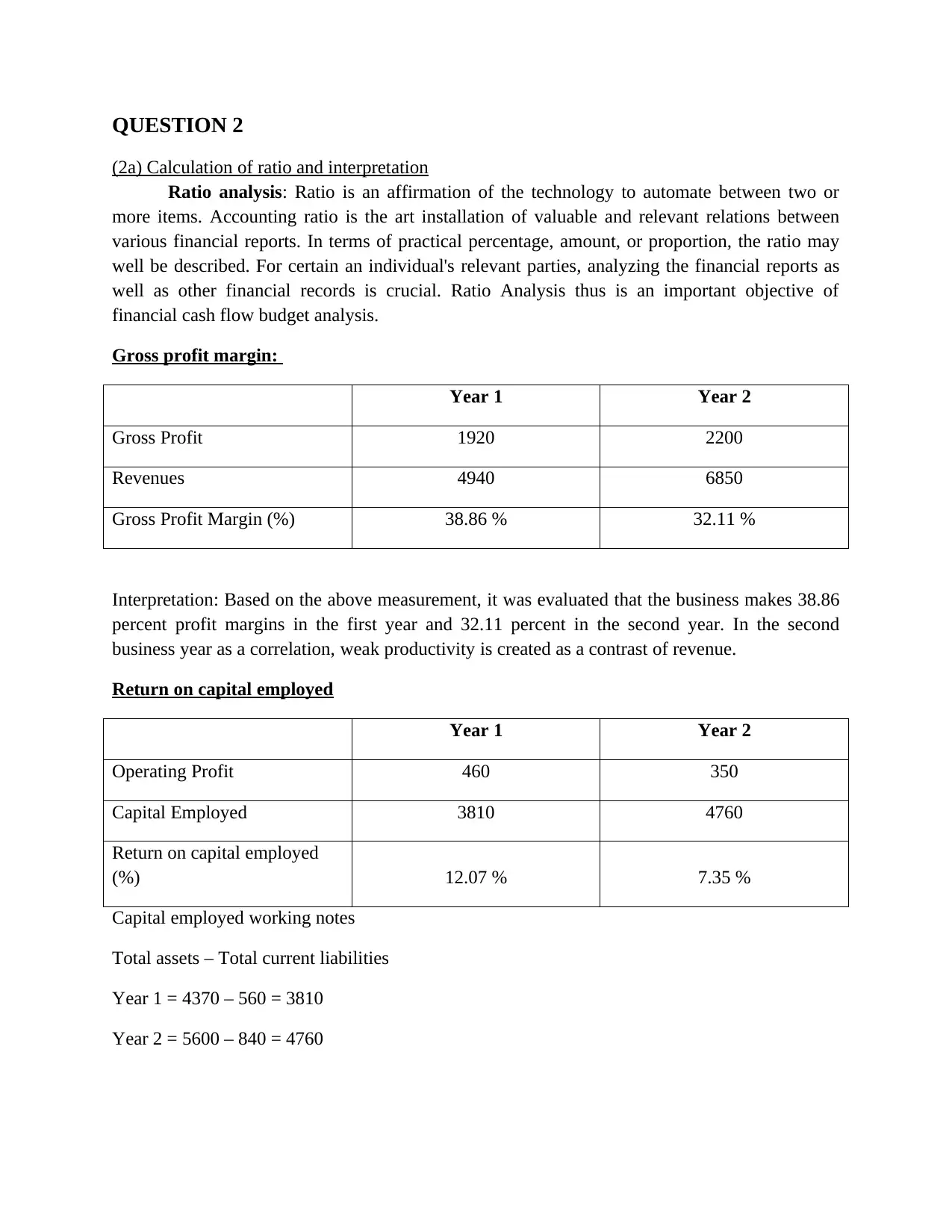
QUESTION 2
(2a) Calculation of ratio and interpretation
Ratio analysis: Ratio is an affirmation of the technology to automate between two or
more items. Accounting ratio is the art installation of valuable and relevant relations between
various financial reports. In terms of practical percentage, amount, or proportion, the ratio may
well be described. For certain an individual's relevant parties, analyzing the financial reports as
well as other financial records is crucial. Ratio Analysis thus is an important objective of
financial cash flow budget analysis.
Gross profit margin:
Year 1 Year 2
Gross Profit 1920 2200
Revenues 4940 6850
Gross Profit Margin (%) 38.86 % 32.11 %
Interpretation: Based on the above measurement, it was evaluated that the business makes 38.86
percent profit margins in the first year and 32.11 percent in the second year. In the second
business year as a correlation, weak productivity is created as a contrast of revenue.
Return on capital employed
Year 1 Year 2
Operating Profit 460 350
Capital Employed 3810 4760
Return on capital employed
(%) 12.07 % 7.35 %
Capital employed working notes
Total assets – Total current liabilities
Year 1 = 4370 – 560 = 3810
Year 2 = 5600 – 840 = 4760
(2a) Calculation of ratio and interpretation
Ratio analysis: Ratio is an affirmation of the technology to automate between two or
more items. Accounting ratio is the art installation of valuable and relevant relations between
various financial reports. In terms of practical percentage, amount, or proportion, the ratio may
well be described. For certain an individual's relevant parties, analyzing the financial reports as
well as other financial records is crucial. Ratio Analysis thus is an important objective of
financial cash flow budget analysis.
Gross profit margin:
Year 1 Year 2
Gross Profit 1920 2200
Revenues 4940 6850
Gross Profit Margin (%) 38.86 % 32.11 %
Interpretation: Based on the above measurement, it was evaluated that the business makes 38.86
percent profit margins in the first year and 32.11 percent in the second year. In the second
business year as a correlation, weak productivity is created as a contrast of revenue.
Return on capital employed
Year 1 Year 2
Operating Profit 460 350
Capital Employed 3810 4760
Return on capital employed
(%) 12.07 % 7.35 %
Capital employed working notes
Total assets – Total current liabilities
Year 1 = 4370 – 560 = 3810
Year 2 = 5600 – 840 = 4760
Paraphrase This Document
Need a fresh take? Get an instant paraphrase of this document with our AI Paraphraser
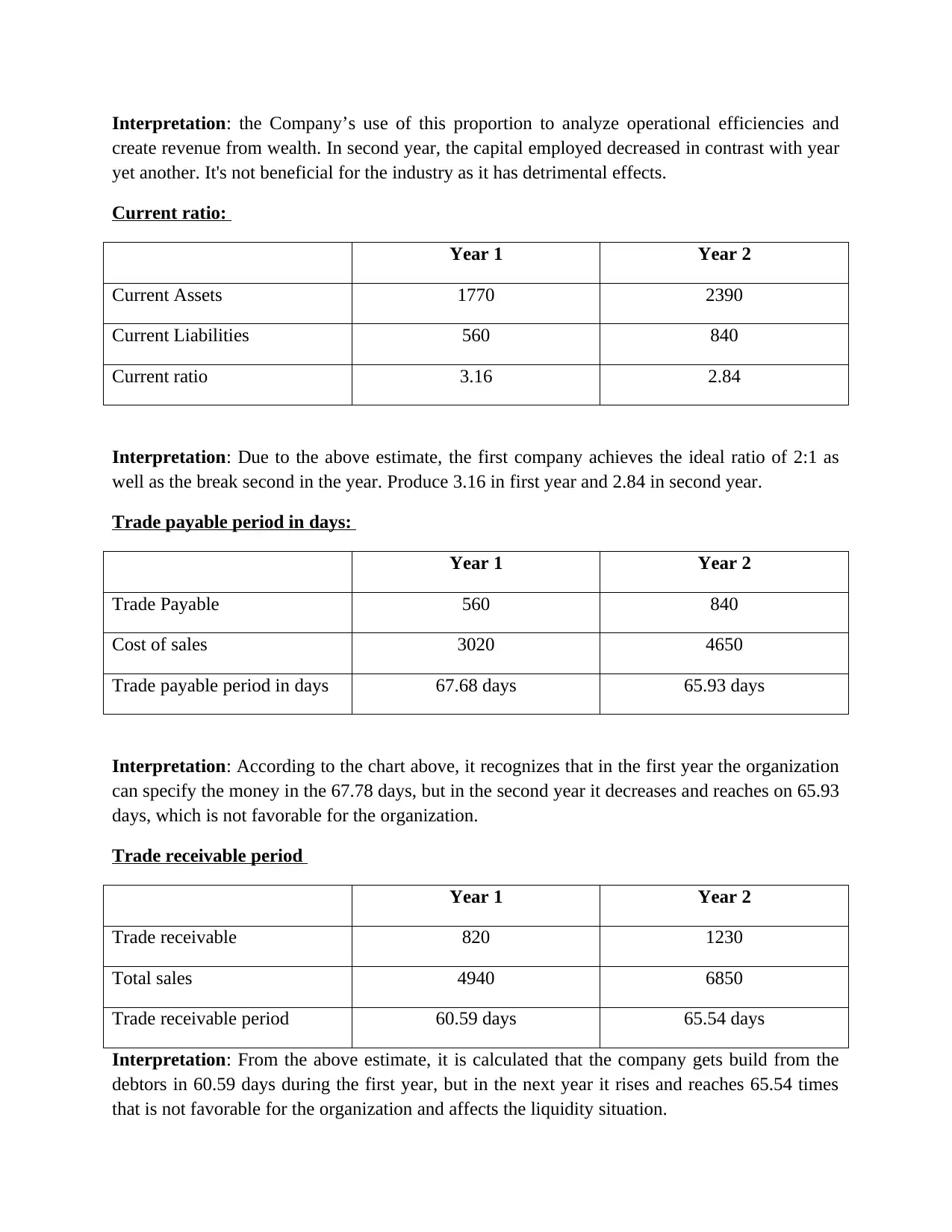
Interpretation: the Company’s use of this proportion to analyze operational efficiencies and
create revenue from wealth. In second year, the capital employed decreased in contrast with year
yet another. It's not beneficial for the industry as it has detrimental effects.
Current ratio:
Year 1 Year 2
Current Assets 1770 2390
Current Liabilities 560 840
Current ratio 3.16 2.84
Interpretation: Due to the above estimate, the first company achieves the ideal ratio of 2:1 as
well as the break second in the year. Produce 3.16 in first year and 2.84 in second year.
Trade payable period in days:
Year 1 Year 2
Trade Payable 560 840
Cost of sales 3020 4650
Trade payable period in days 67.68 days 65.93 days
Interpretation: According to the chart above, it recognizes that in the first year the organization
can specify the money in the 67.78 days, but in the second year it decreases and reaches on 65.93
days, which is not favorable for the organization.
Trade receivable period
Year 1 Year 2
Trade receivable 820 1230
Total sales 4940 6850
Trade receivable period 60.59 days 65.54 days
Interpretation: From the above estimate, it is calculated that the company gets build from the
debtors in 60.59 days during the first year, but in the next year it rises and reaches 65.54 times
that is not favorable for the organization and affects the liquidity situation.
create revenue from wealth. In second year, the capital employed decreased in contrast with year
yet another. It's not beneficial for the industry as it has detrimental effects.
Current ratio:
Year 1 Year 2
Current Assets 1770 2390
Current Liabilities 560 840
Current ratio 3.16 2.84
Interpretation: Due to the above estimate, the first company achieves the ideal ratio of 2:1 as
well as the break second in the year. Produce 3.16 in first year and 2.84 in second year.
Trade payable period in days:
Year 1 Year 2
Trade Payable 560 840
Cost of sales 3020 4650
Trade payable period in days 67.68 days 65.93 days
Interpretation: According to the chart above, it recognizes that in the first year the organization
can specify the money in the 67.78 days, but in the second year it decreases and reaches on 65.93
days, which is not favorable for the organization.
Trade receivable period
Year 1 Year 2
Trade receivable 820 1230
Total sales 4940 6850
Trade receivable period 60.59 days 65.54 days
Interpretation: From the above estimate, it is calculated that the company gets build from the
debtors in 60.59 days during the first year, but in the next year it rises and reaches 65.54 times
that is not favorable for the organization and affects the liquidity situation.
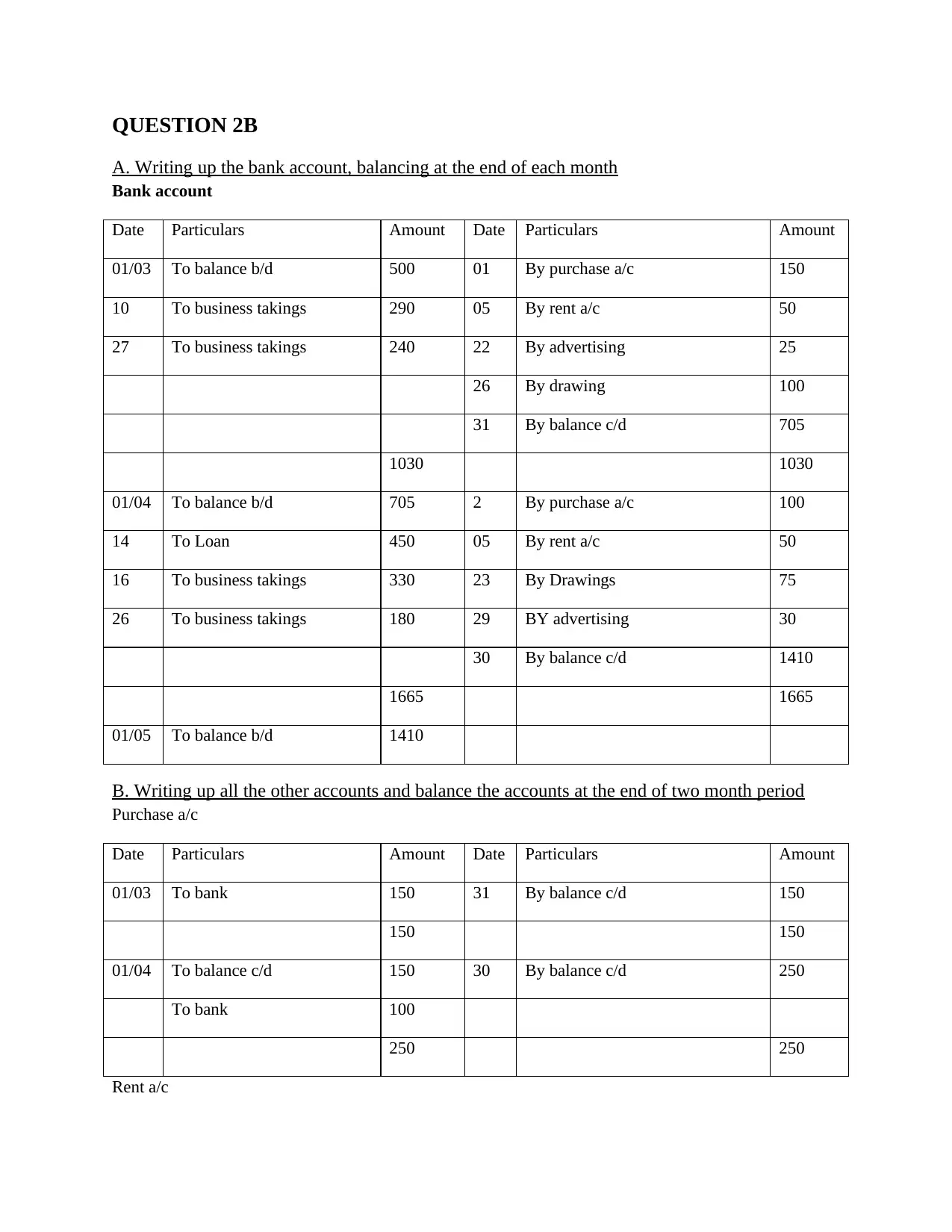
QUESTION 2B
A. Writing up the bank account, balancing at the end of each month
Bank account
Date Particulars Amount Date Particulars Amount
01/03 To balance b/d 500 01 By purchase a/c 150
10 To business takings 290 05 By rent a/c 50
27 To business takings 240 22 By advertising 25
26 By drawing 100
31 By balance c/d 705
1030 1030
01/04 To balance b/d 705 2 By purchase a/c 100
14 To Loan 450 05 By rent a/c 50
16 To business takings 330 23 By Drawings 75
26 To business takings 180 29 BY advertising 30
30 By balance c/d 1410
1665 1665
01/05 To balance b/d 1410
B. Writing up all the other accounts and balance the accounts at the end of two month period
Purchase a/c
Date Particulars Amount Date Particulars Amount
01/03 To bank 150 31 By balance c/d 150
150 150
01/04 To balance c/d 150 30 By balance c/d 250
To bank 100
250 250
Rent a/c
A. Writing up the bank account, balancing at the end of each month
Bank account
Date Particulars Amount Date Particulars Amount
01/03 To balance b/d 500 01 By purchase a/c 150
10 To business takings 290 05 By rent a/c 50
27 To business takings 240 22 By advertising 25
26 By drawing 100
31 By balance c/d 705
1030 1030
01/04 To balance b/d 705 2 By purchase a/c 100
14 To Loan 450 05 By rent a/c 50
16 To business takings 330 23 By Drawings 75
26 To business takings 180 29 BY advertising 30
30 By balance c/d 1410
1665 1665
01/05 To balance b/d 1410
B. Writing up all the other accounts and balance the accounts at the end of two month period
Purchase a/c
Date Particulars Amount Date Particulars Amount
01/03 To bank 150 31 By balance c/d 150
150 150
01/04 To balance c/d 150 30 By balance c/d 250
To bank 100
250 250
Rent a/c
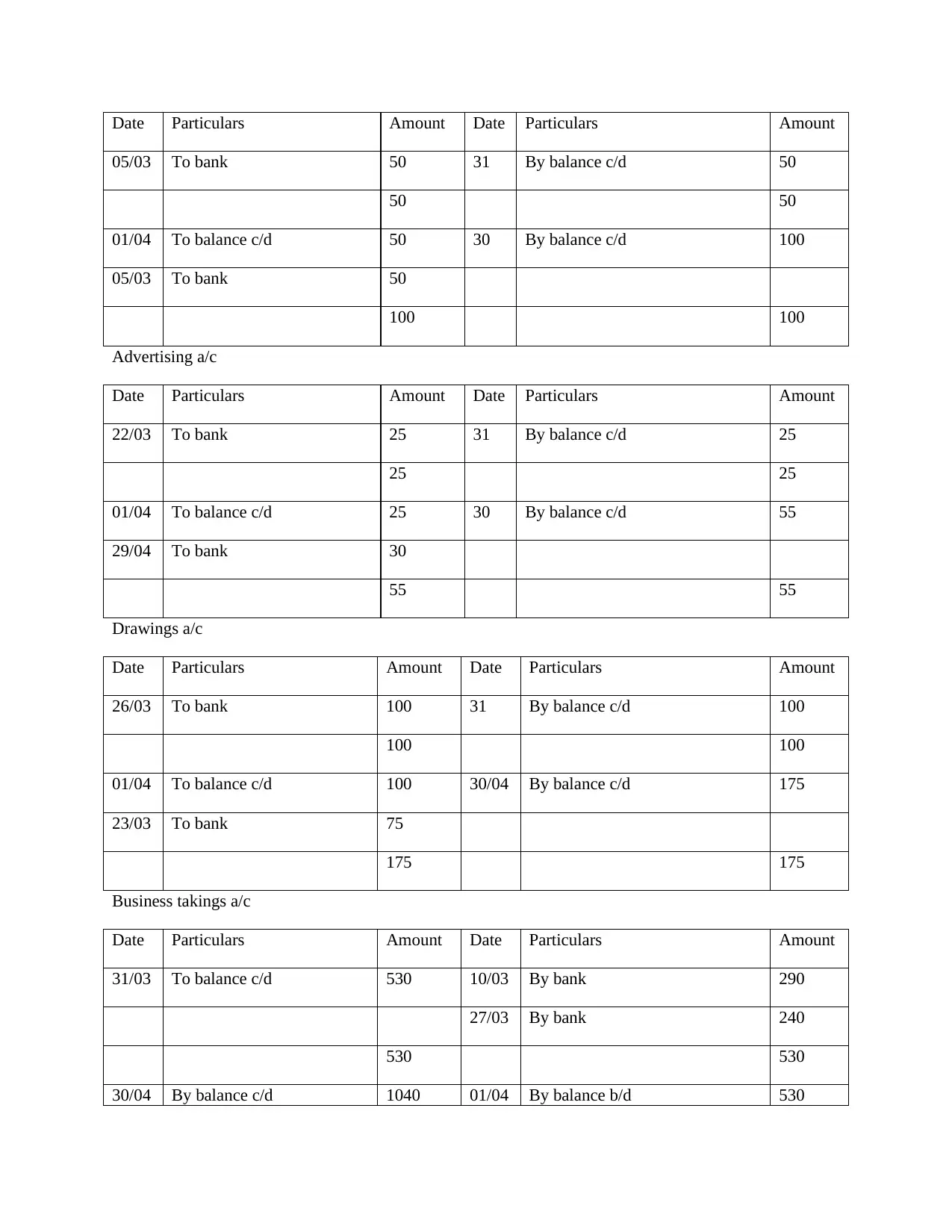
Date Particulars Amount Date Particulars Amount
05/03 To bank 50 31 By balance c/d 50
50 50
01/04 To balance c/d 50 30 By balance c/d 100
05/03 To bank 50
100 100
Advertising a/c
Date Particulars Amount Date Particulars Amount
22/03 To bank 25 31 By balance c/d 25
25 25
01/04 To balance c/d 25 30 By balance c/d 55
29/04 To bank 30
55 55
Drawings a/c
Date Particulars Amount Date Particulars Amount
26/03 To bank 100 31 By balance c/d 100
100 100
01/04 To balance c/d 100 30/04 By balance c/d 175
23/03 To bank 75
175 175
Business takings a/c
Date Particulars Amount Date Particulars Amount
31/03 To balance c/d 530 10/03 By bank 290
27/03 By bank 240
530 530
30/04 By balance c/d 1040 01/04 By balance b/d 530
05/03 To bank 50 31 By balance c/d 50
50 50
01/04 To balance c/d 50 30 By balance c/d 100
05/03 To bank 50
100 100
Advertising a/c
Date Particulars Amount Date Particulars Amount
22/03 To bank 25 31 By balance c/d 25
25 25
01/04 To balance c/d 25 30 By balance c/d 55
29/04 To bank 30
55 55
Drawings a/c
Date Particulars Amount Date Particulars Amount
26/03 To bank 100 31 By balance c/d 100
100 100
01/04 To balance c/d 100 30/04 By balance c/d 175
23/03 To bank 75
175 175
Business takings a/c
Date Particulars Amount Date Particulars Amount
31/03 To balance c/d 530 10/03 By bank 290
27/03 By bank 240
530 530
30/04 By balance c/d 1040 01/04 By balance b/d 530
Secure Best Marks with AI Grader
Need help grading? Try our AI Grader for instant feedback on your assignments.
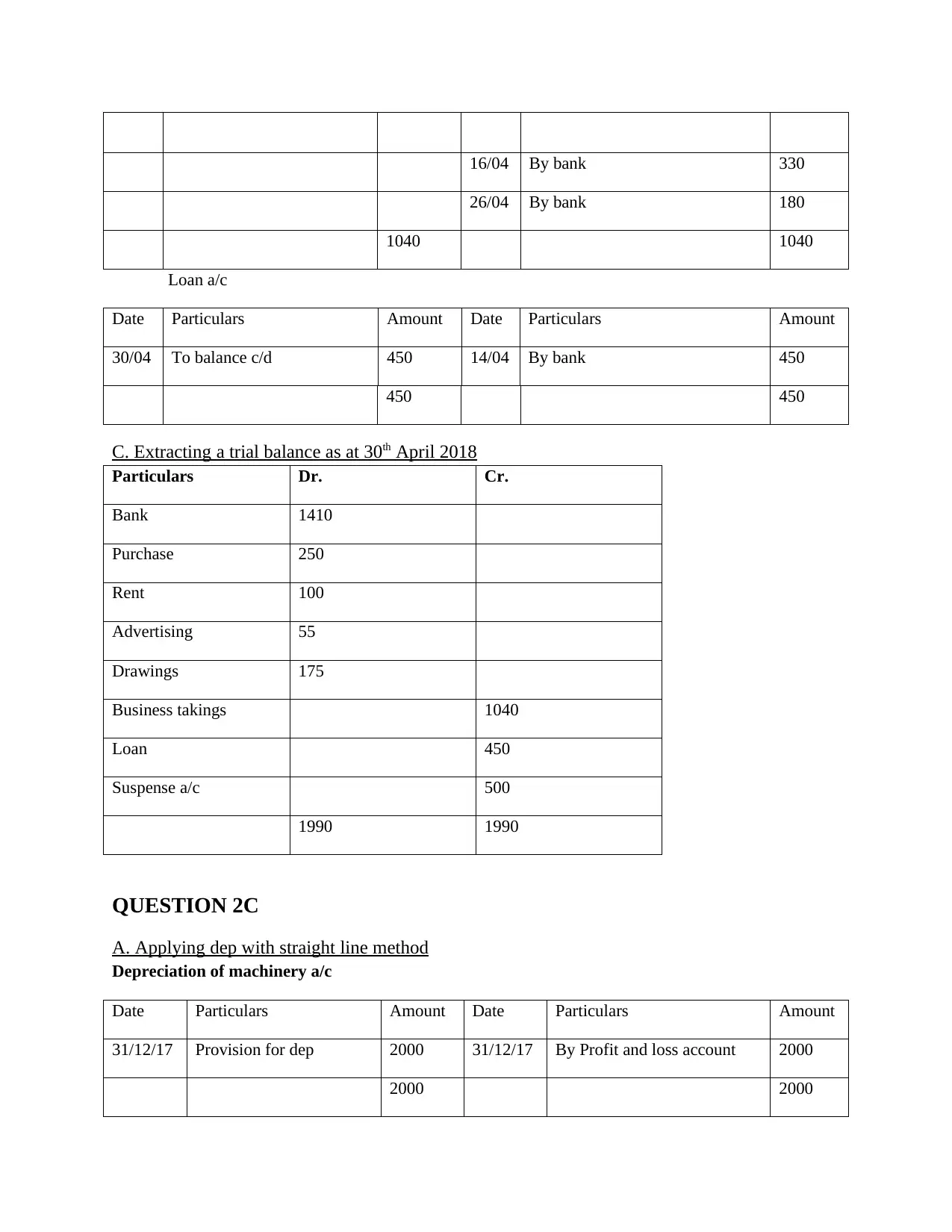
16/04 By bank 330
26/04 By bank 180
1040 1040
Loan a/c
Date Particulars Amount Date Particulars Amount
30/04 To balance c/d 450 14/04 By bank 450
450 450
C. Extracting a trial balance as at 30th April 2018
Particulars Dr. Cr.
Bank 1410
Purchase 250
Rent 100
Advertising 55
Drawings 175
Business takings 1040
Loan 450
Suspense a/c 500
1990 1990
QUESTION 2C
A. Applying dep with straight line method
Depreciation of machinery a/c
Date Particulars Amount Date Particulars Amount
31/12/17 Provision for dep 2000 31/12/17 By Profit and loss account 2000
2000 2000
26/04 By bank 180
1040 1040
Loan a/c
Date Particulars Amount Date Particulars Amount
30/04 To balance c/d 450 14/04 By bank 450
450 450
C. Extracting a trial balance as at 30th April 2018
Particulars Dr. Cr.
Bank 1410
Purchase 250
Rent 100
Advertising 55
Drawings 175
Business takings 1040
Loan 450
Suspense a/c 500
1990 1990
QUESTION 2C
A. Applying dep with straight line method
Depreciation of machinery a/c
Date Particulars Amount Date Particulars Amount
31/12/17 Provision for dep 2000 31/12/17 By Profit and loss account 2000
2000 2000
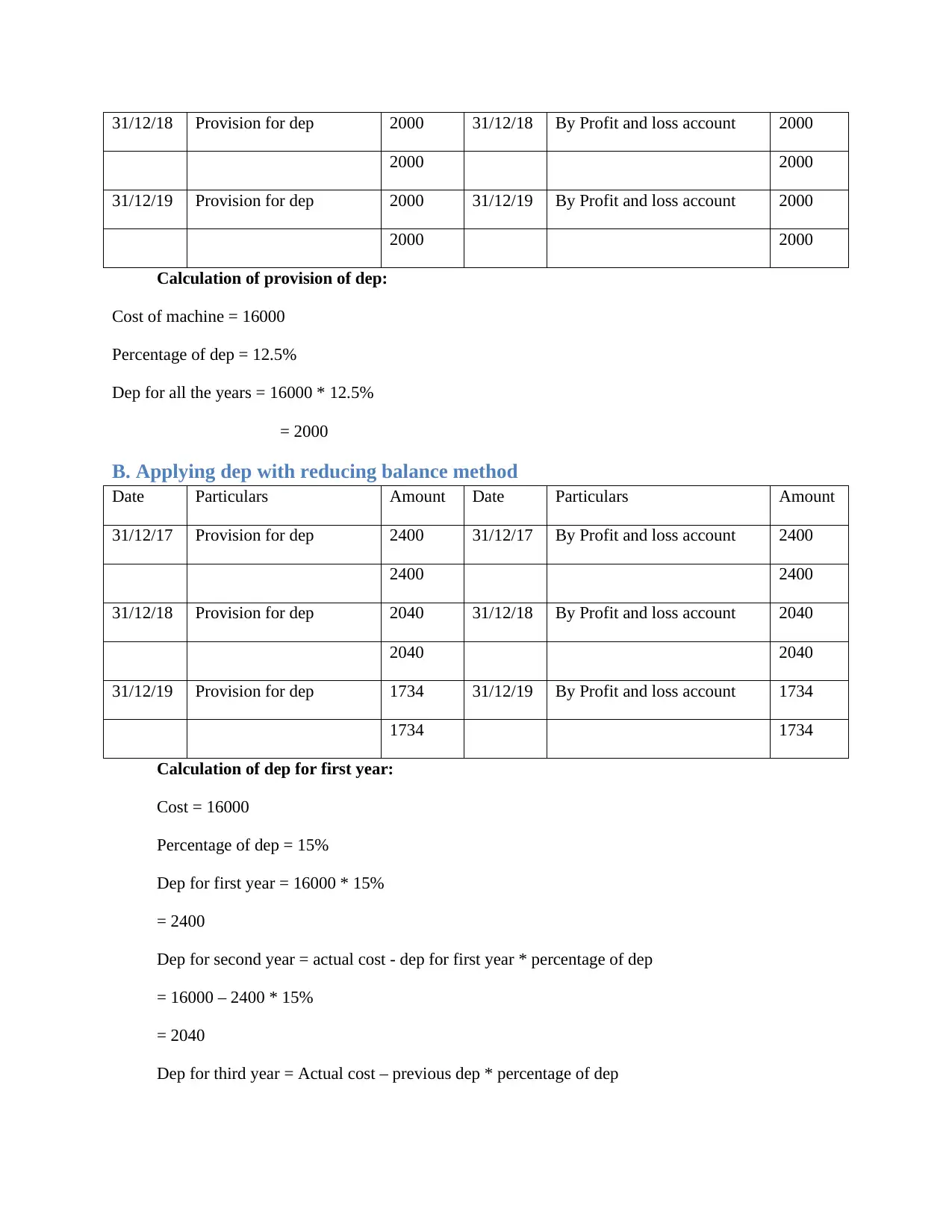
31/12/18 Provision for dep 2000 31/12/18 By Profit and loss account 2000
2000 2000
31/12/19 Provision for dep 2000 31/12/19 By Profit and loss account 2000
2000 2000
Calculation of provision of dep:
Cost of machine = 16000
Percentage of dep = 12.5%
Dep for all the years = 16000 * 12.5%
= 2000
B. Applying dep with reducing balance method
Date Particulars Amount Date Particulars Amount
31/12/17 Provision for dep 2400 31/12/17 By Profit and loss account 2400
2400 2400
31/12/18 Provision for dep 2040 31/12/18 By Profit and loss account 2040
2040 2040
31/12/19 Provision for dep 1734 31/12/19 By Profit and loss account 1734
1734 1734
Calculation of dep for first year:
Cost = 16000
Percentage of dep = 15%
Dep for first year = 16000 * 15%
= 2400
Dep for second year = actual cost - dep for first year * percentage of dep
= 16000 – 2400 * 15%
= 2040
Dep for third year = Actual cost – previous dep * percentage of dep
2000 2000
31/12/19 Provision for dep 2000 31/12/19 By Profit and loss account 2000
2000 2000
Calculation of provision of dep:
Cost of machine = 16000
Percentage of dep = 12.5%
Dep for all the years = 16000 * 12.5%
= 2000
B. Applying dep with reducing balance method
Date Particulars Amount Date Particulars Amount
31/12/17 Provision for dep 2400 31/12/17 By Profit and loss account 2400
2400 2400
31/12/18 Provision for dep 2040 31/12/18 By Profit and loss account 2040
2040 2040
31/12/19 Provision for dep 1734 31/12/19 By Profit and loss account 1734
1734 1734
Calculation of dep for first year:
Cost = 16000
Percentage of dep = 15%
Dep for first year = 16000 * 15%
= 2400
Dep for second year = actual cost - dep for first year * percentage of dep
= 16000 – 2400 * 15%
= 2040
Dep for third year = Actual cost – previous dep * percentage of dep
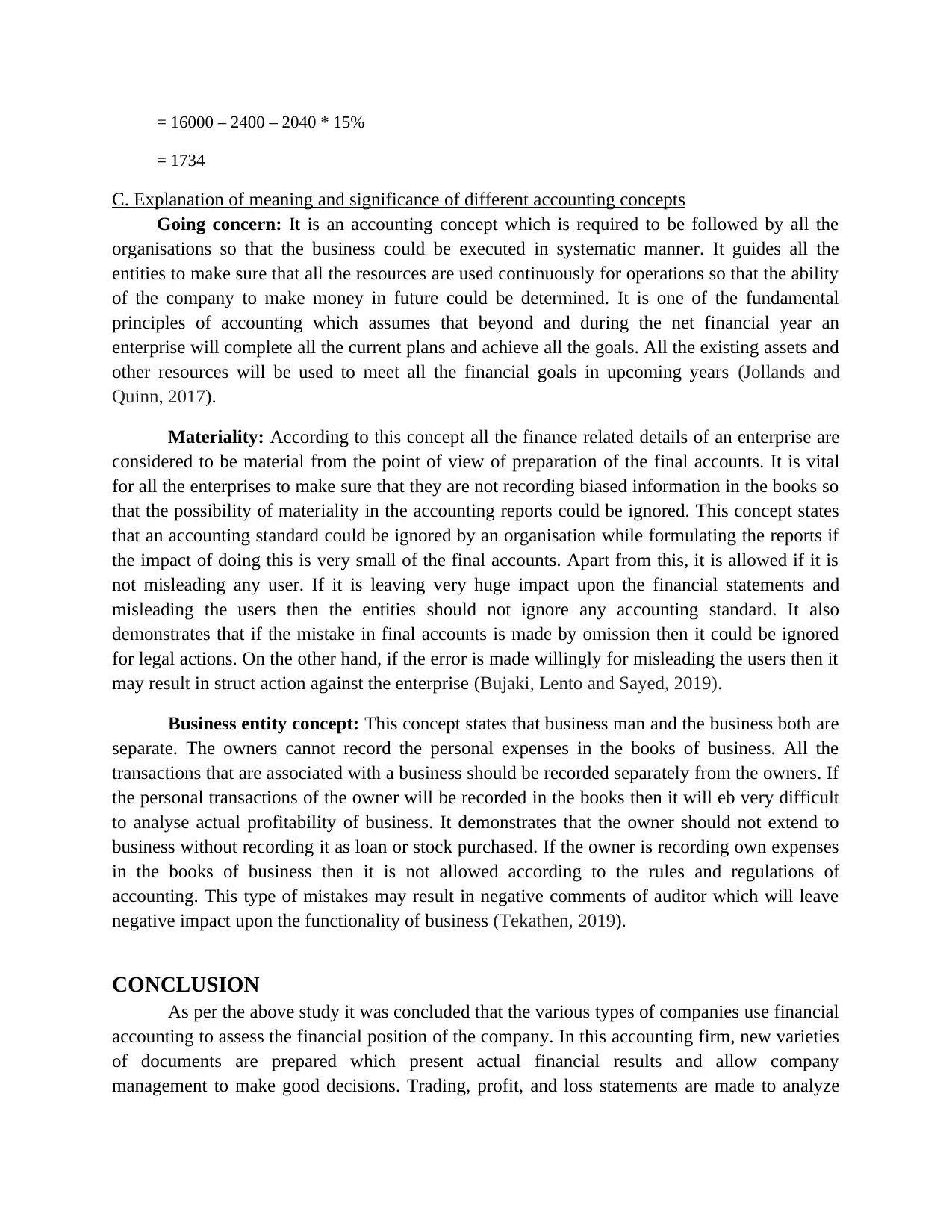
= 16000 – 2400 – 2040 * 15%
= 1734
C. Explanation of meaning and significance of different accounting concepts
Going concern: It is an accounting concept which is required to be followed by all the
organisations so that the business could be executed in systematic manner. It guides all the
entities to make sure that all the resources are used continuously for operations so that the ability
of the company to make money in future could be determined. It is one of the fundamental
principles of accounting which assumes that beyond and during the net financial year an
enterprise will complete all the current plans and achieve all the goals. All the existing assets and
other resources will be used to meet all the financial goals in upcoming years (Jollands and
Quinn, 2017).
Materiality: According to this concept all the finance related details of an enterprise are
considered to be material from the point of view of preparation of the final accounts. It is vital
for all the enterprises to make sure that they are not recording biased information in the books so
that the possibility of materiality in the accounting reports could be ignored. This concept states
that an accounting standard could be ignored by an organisation while formulating the reports if
the impact of doing this is very small of the final accounts. Apart from this, it is allowed if it is
not misleading any user. If it is leaving very huge impact upon the financial statements and
misleading the users then the entities should not ignore any accounting standard. It also
demonstrates that if the mistake in final accounts is made by omission then it could be ignored
for legal actions. On the other hand, if the error is made willingly for misleading the users then it
may result in struct action against the enterprise (Bujaki, Lento and Sayed, 2019).
Business entity concept: This concept states that business man and the business both are
separate. The owners cannot record the personal expenses in the books of business. All the
transactions that are associated with a business should be recorded separately from the owners. If
the personal transactions of the owner will be recorded in the books then it will eb very difficult
to analyse actual profitability of business. It demonstrates that the owner should not extend to
business without recording it as loan or stock purchased. If the owner is recording own expenses
in the books of business then it is not allowed according to the rules and regulations of
accounting. This type of mistakes may result in negative comments of auditor which will leave
negative impact upon the functionality of business (Tekathen, 2019).
CONCLUSION
As per the above study it was concluded that the various types of companies use financial
accounting to assess the financial position of the company. In this accounting firm, new varieties
of documents are prepared which present actual financial results and allow company
management to make good decisions. Trading, profit, and loss statements are made to analyze
= 1734
C. Explanation of meaning and significance of different accounting concepts
Going concern: It is an accounting concept which is required to be followed by all the
organisations so that the business could be executed in systematic manner. It guides all the
entities to make sure that all the resources are used continuously for operations so that the ability
of the company to make money in future could be determined. It is one of the fundamental
principles of accounting which assumes that beyond and during the net financial year an
enterprise will complete all the current plans and achieve all the goals. All the existing assets and
other resources will be used to meet all the financial goals in upcoming years (Jollands and
Quinn, 2017).
Materiality: According to this concept all the finance related details of an enterprise are
considered to be material from the point of view of preparation of the final accounts. It is vital
for all the enterprises to make sure that they are not recording biased information in the books so
that the possibility of materiality in the accounting reports could be ignored. This concept states
that an accounting standard could be ignored by an organisation while formulating the reports if
the impact of doing this is very small of the final accounts. Apart from this, it is allowed if it is
not misleading any user. If it is leaving very huge impact upon the financial statements and
misleading the users then the entities should not ignore any accounting standard. It also
demonstrates that if the mistake in final accounts is made by omission then it could be ignored
for legal actions. On the other hand, if the error is made willingly for misleading the users then it
may result in struct action against the enterprise (Bujaki, Lento and Sayed, 2019).
Business entity concept: This concept states that business man and the business both are
separate. The owners cannot record the personal expenses in the books of business. All the
transactions that are associated with a business should be recorded separately from the owners. If
the personal transactions of the owner will be recorded in the books then it will eb very difficult
to analyse actual profitability of business. It demonstrates that the owner should not extend to
business without recording it as loan or stock purchased. If the owner is recording own expenses
in the books of business then it is not allowed according to the rules and regulations of
accounting. This type of mistakes may result in negative comments of auditor which will leave
negative impact upon the functionality of business (Tekathen, 2019).
CONCLUSION
As per the above study it was concluded that the various types of companies use financial
accounting to assess the financial position of the company. In this accounting firm, new varieties
of documents are prepared which present actual financial results and allow company
management to make good decisions. Trading, profit, and loss statements are made to analyze
Paraphrase This Document
Need a fresh take? Get an instant paraphrase of this document with our AI Paraphraser
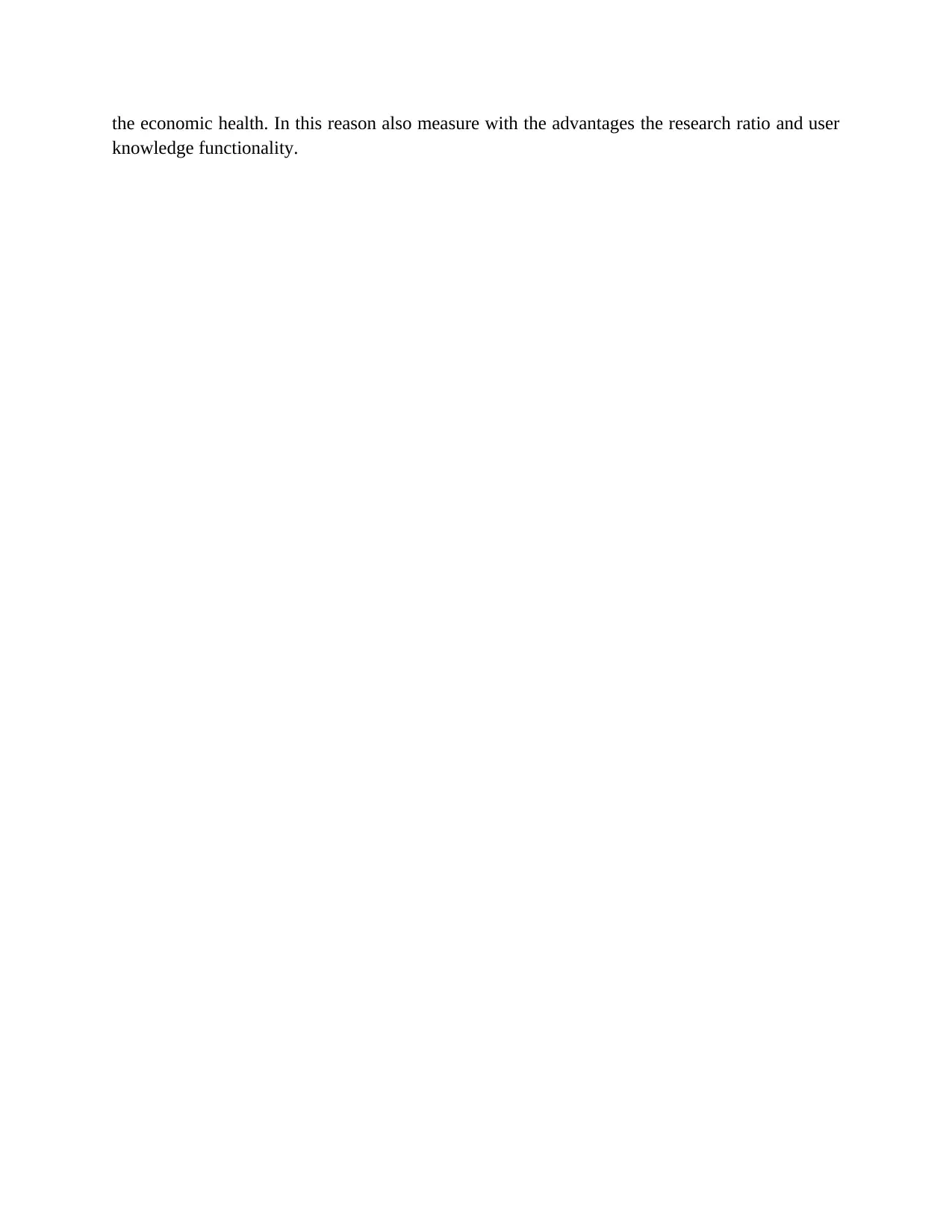
the economic health. In this reason also measure with the advantages the research ratio and user
knowledge functionality.
knowledge functionality.
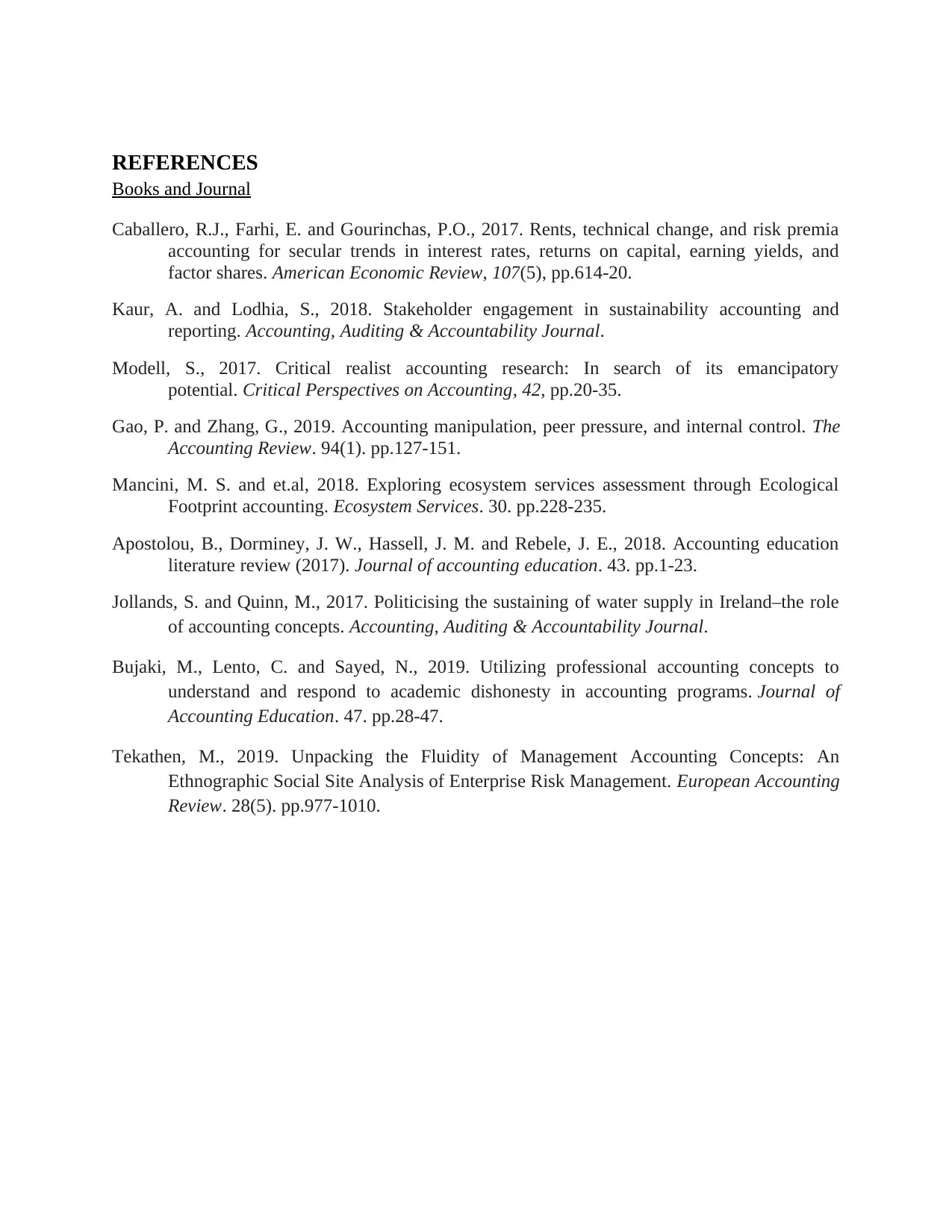
REFERENCES
Books and Journal
Caballero, R.J., Farhi, E. and Gourinchas, P.O., 2017. Rents, technical change, and risk premia
accounting for secular trends in interest rates, returns on capital, earning yields, and
factor shares. American Economic Review, 107(5), pp.614-20.
Kaur, A. and Lodhia, S., 2018. Stakeholder engagement in sustainability accounting and
reporting. Accounting, Auditing & Accountability Journal.
Modell, S., 2017. Critical realist accounting research: In search of its emancipatory
potential. Critical Perspectives on Accounting, 42, pp.20-35.
Gao, P. and Zhang, G., 2019. Accounting manipulation, peer pressure, and internal control. The
Accounting Review. 94(1). pp.127-151.
Mancini, M. S. and et.al, 2018. Exploring ecosystem services assessment through Ecological
Footprint accounting. Ecosystem Services. 30. pp.228-235.
Apostolou, B., Dorminey, J. W., Hassell, J. M. and Rebele, J. E., 2018. Accounting education
literature review (2017). Journal of accounting education. 43. pp.1-23.
Jollands, S. and Quinn, M., 2017. Politicising the sustaining of water supply in Ireland–the role
of accounting concepts. Accounting, Auditing & Accountability Journal.
Bujaki, M., Lento, C. and Sayed, N., 2019. Utilizing professional accounting concepts to
understand and respond to academic dishonesty in accounting programs. Journal of
Accounting Education. 47. pp.28-47.
Tekathen, M., 2019. Unpacking the Fluidity of Management Accounting Concepts: An
Ethnographic Social Site Analysis of Enterprise Risk Management. European Accounting
Review. 28(5). pp.977-1010.
Books and Journal
Caballero, R.J., Farhi, E. and Gourinchas, P.O., 2017. Rents, technical change, and risk premia
accounting for secular trends in interest rates, returns on capital, earning yields, and
factor shares. American Economic Review, 107(5), pp.614-20.
Kaur, A. and Lodhia, S., 2018. Stakeholder engagement in sustainability accounting and
reporting. Accounting, Auditing & Accountability Journal.
Modell, S., 2017. Critical realist accounting research: In search of its emancipatory
potential. Critical Perspectives on Accounting, 42, pp.20-35.
Gao, P. and Zhang, G., 2019. Accounting manipulation, peer pressure, and internal control. The
Accounting Review. 94(1). pp.127-151.
Mancini, M. S. and et.al, 2018. Exploring ecosystem services assessment through Ecological
Footprint accounting. Ecosystem Services. 30. pp.228-235.
Apostolou, B., Dorminey, J. W., Hassell, J. M. and Rebele, J. E., 2018. Accounting education
literature review (2017). Journal of accounting education. 43. pp.1-23.
Jollands, S. and Quinn, M., 2017. Politicising the sustaining of water supply in Ireland–the role
of accounting concepts. Accounting, Auditing & Accountability Journal.
Bujaki, M., Lento, C. and Sayed, N., 2019. Utilizing professional accounting concepts to
understand and respond to academic dishonesty in accounting programs. Journal of
Accounting Education. 47. pp.28-47.
Tekathen, M., 2019. Unpacking the Fluidity of Management Accounting Concepts: An
Ethnographic Social Site Analysis of Enterprise Risk Management. European Accounting
Review. 28(5). pp.977-1010.
1 out of 15
Related Documents
Your All-in-One AI-Powered Toolkit for Academic Success.
+13062052269
info@desklib.com
Available 24*7 on WhatsApp / Email
![[object Object]](/_next/static/media/star-bottom.7253800d.svg)
Unlock your academic potential
© 2024 | Zucol Services PVT LTD | All rights reserved.




